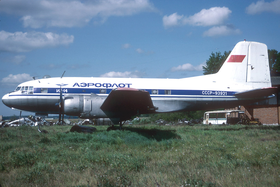Aeroflot flight 40
| Aeroflot flight 40 | |
|---|---|
|
Identical aircraft of the airline |
|
| Accident summary | |
| Accident type | Crash landing after engine failure |
| place | Near Yangiyoʻl , Uzbek SSR |
| date | July 6, 1962 |
| Fatalities | 11 |
| Survivors | 27 |
| Aircraft | |
| Aircraft type |
Ilyushin Il-14 , Soviet Union |
| operator |
Aeroflot , Soviet Union |
| Mark | CCCP-91554, Soviet Union |
| Departure airport |
Buxoro Airport , Uzbek SSR |
| Destination airport |
Tashkent Airport , Uzbek SSR |
| Passengers | 33 |
| crew | 5 |
| Lists of aviation accidents | |
On July 6, 1962, on the internal Soviet scheduled flight Aeroflot flight 40 from Bukhara to Tashkent , the Il-14 crash-landed after an engine failure, killing 11 of the 38 occupants. An American student was also among the injured passengers , which made the accident known in the West .
Plane and crew
The aircraft was an Ilyushin Il-14 ( aircraft registration: CCCP-91554, serial number : 147001216), which had completed 11,030 flight hours from January 31, 1957 until the accident. The crew consisted of captain Boris Denissowitsch Volosowitsch, first officer Boris Tichonowitsch Boronin, flight engineer Nikolai Ivanovich Ananyev, navigator Vladimir Vasilyevich Semenko and flight attendant Klara Ilyinichna Popova.
course
The plane was supposed to serve the double flight Aeroflot flight 39/40 Tashkent - Samarkand- Buchara-Tashkent that day . At 10:05 a.m. local time , the Il-14 took off for Flight 40 on a clear day and rose to a cruising altitude of 3000 m. At 10:35 a.m., the pilots reported the failure of the right engine by burning out engine cylinder no. 2 and asked for clearance to continue the flight to Tashkent at 2400 m. Captain Wolosowitsch followed the advice of flight engineer Ananyev to refrain from an emergency landing and thus not get an entry in his personnel file. At the time of the engine failure, he could have canceled the onward flight and landed in Bukhara (135 km) or Navoi (65 km), even if they had decided to do so 10 minutes later, although the landing in Bukhara would have been less safe. The air traffic controllers did not issue a landing recommendation and did not otherwise intervene in the situation. After receiving clearance to descend, the aircraft sank to 1,500 m and then approached Tashkent within the next 15 minutes to within 120 km.
Volosowitsch was focused on the mere single-engine onward flight and Ananyev, without reporting it, throttled the functioning left engine for fear of failure; it was not clear to him that this would prevent the plane from maintaining altitude. Volosowitsch, on the other hand, did not notice the steady loss of altitude, since he did not monitor the altitude, and also missed the opportunity to land on the Schardara airfield with the landing gear retracted .
Later on, the pilots reported an altitude of 400 m and a normal temperature in the left engine. The pilots' superior, who had meanwhile arrived in Tashkent, asked them to increase the thrust back to normal. Due to radio interference, the pilots did not understand the instruction and only followed it when the Il-14 had sunk to 200 m. After a further 5 minutes of flight, the pilots tried to start the right engine at a height of 100 m and therefore took the propeller out of the sail position . The resulting increased air resistance led to a drop in speed and stall , whereupon the aircraft rolled to the right and the right wing grazed the 2.5 m high fence of a cattle ranch named after Friedrich Engels and hit a cotton field 50 m further at 12:15 p.m., 34 km from Tashkent. As a result, the fuselage broke into 3 parts and the left engine broke off the wing without a fire breaking out. nine passengers died at the scene of the accident, two more died the following day in the hospital .
root cause
The investigators were able to confirm, as reported by the captain Volosowitsch, that the right engine failed due to the burning out of cylinder head No. 2 (the ones used in the Schwezow ASch-82 were found to be unreliable), and they made this the main cause of the accident. They saw Volosovich's actions as the immediate cause.
- Failure to return to the departure airport despite the engine failure and continuation of the flight to the destination airport
- Inadequate guidance on his part, which, together with the general inadequate communication among the pilots, allowed an unnecessary reduction in thrust, which meant that the altitude could not be maintained
- Failure to land at a suitable airport along the route
- The wrong decision to restart the right engine at a low altitude
Similar cases
Flight accident of the Ilyushin Il-14 CCCP-61618 of Aeroflot on January 1, 1966: In this case, too, the pilots of an Il-14 tried to reach the destination airport despite the engine failure and alternative landing options.
swell
- Accident description (English) IL-14 CCCP-91554 on the Aviation Safety Network , accessed on June 18, 2020
- Description of the accident (Russian) on airdisaster.ru, accessed on June 18, 2020
- Description of the accident (Russian) on avia.pro, accessed on June 18, 2020
